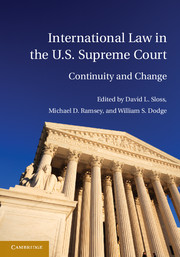Book contents
- Frontmatter
- Contents
- List of Contributors
- Table of Cases
- Acknowledgments
- Introduction
- PART I FROM THE FOUNDING TO THE CIVIL WAR
- PART II FROM THE CIVIL WAR TO THE TURN OF THE CENTURY
- PART III FROM THE TURN OF THE CENTURY TO WORLD WAR II
- 6 Treaties in the Supreme Court, 1901–1945
- 7 Customary International Law in the Supreme Court, 1901–1945
- 8 International Law as an Interpretive Tool in the Supreme Court, 1901–1945
- 9 Varieties and Complexities of Doctrinal Change: Historical Commentary, 1901–1945
- PART IV FROM WORLD WAR II TO THE NEW MILLENNIUM
- PART V INTERNATIONAL LAW IN THE U.S. SUPREME COURT IN THE TWENTY-FIRST CENTURY
- V.A TREATIES AFTER 2000
- V.B CUSTOMARY INTERNATIONAL LAW AFTER 2000
- V.C INTERNATIONAL LAW AND CONSTITUTIONAL INTERPRETATION AFTER 2000
- V.D INTERNATIONAL LAW AND STATUTORY INTERPRETATION AFTER 2000
- V.E INTERNATIONAL LAW AND THE WAR ON TERROR
- VI CONCLUSION
- Index
- References
8 - International Law as an Interpretive Tool in the Supreme Court, 1901–1945
Published online by Cambridge University Press: 05 July 2011
- Frontmatter
- Contents
- List of Contributors
- Table of Cases
- Acknowledgments
- Introduction
- PART I FROM THE FOUNDING TO THE CIVIL WAR
- PART II FROM THE CIVIL WAR TO THE TURN OF THE CENTURY
- PART III FROM THE TURN OF THE CENTURY TO WORLD WAR II
- 6 Treaties in the Supreme Court, 1901–1945
- 7 Customary International Law in the Supreme Court, 1901–1945
- 8 International Law as an Interpretive Tool in the Supreme Court, 1901–1945
- 9 Varieties and Complexities of Doctrinal Change: Historical Commentary, 1901–1945
- PART IV FROM WORLD WAR II TO THE NEW MILLENNIUM
- PART V INTERNATIONAL LAW IN THE U.S. SUPREME COURT IN THE TWENTY-FIRST CENTURY
- V.A TREATIES AFTER 2000
- V.B CUSTOMARY INTERNATIONAL LAW AFTER 2000
- V.C INTERNATIONAL LAW AND CONSTITUTIONAL INTERPRETATION AFTER 2000
- V.D INTERNATIONAL LAW AND STATUTORY INTERPRETATION AFTER 2000
- V.E INTERNATIONAL LAW AND THE WAR ON TERROR
- VI CONCLUSION
- Index
- References
Summary
At the start of the twentieth century, international law scholars sharply distinguished between two types of sovereignty: external and internal. “Internal sovereignty is that which is inherent in the people of any State…by its municipal constitution or fundamental laws” and that has as its object “internal public law” or “constitutional law.” By contrast, “[e]xternal sovereignty consists in the independence of one political society, in respect to all other political societies.… The law by which it is regulated has…been called external public law…but may more properly be termed international law.” International law focused exclusively on external sovereignty. “From the standpoint of international law, sovereignty is really regarded as signifying the independence of a State from other States.” Such sovereignty is always relative, because “[t]he nature of international relations…forbids us to emphasize the absoluteness of any one State at the expense of the others; since no one community can be regarded as wholly independent of the other members of the society of nations.”
In analyzing the role of international law as an interpretive tool in the first half of the twentieth century, it is useful to keep these distinctions in mind. Before World War II, international law did not concern itself with internal sovereignty, only external sovereignty. The recurring theme during this period is that customary international law supports government action rather than curtails it. Frequently we see customary international law (and sometimes foreign experience) supporting an expansive understanding of sovereignty that imposes few limits on the exercise of government power.
- Type
- Chapter
- Information
- International Law in the U.S. Supreme Court , pp. 257 - 284Publisher: Cambridge University PressPrint publication year: 2011



